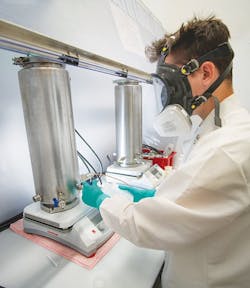PFAS Battle Heats Up: Chemical Industry Races for Breakthrough Destruction Technologies
First commercially produced in the 1940s, the family of per- and polyfluoroalkyl substances (PFAS) known today boasts thousands of members. The rock-solid carbon-fluorine bonds guarantee thermal and chemical stability, while other chemical groups make them repel water, oil and fats. This is why they are a mainstay in so many industrial and consumer products.
Related Content:
EPA Issues New Standard to Combat PFAS Pollution in Drinking Water, ACC Responds
EPA Updates Guidance on PFAS Waste
Chemical Processing Notebook: Bracing for the Regulatory Onslaught
$1.2M Defense Department Grant to Fund PFAS-Destruction Technology
The role of reverse osmosis in wastewater treatment
But the same properties are behind their health risks. Nearly a 25 years after PFAS were first detected in human serum, a large and rapidly growing body of peer-reviewed studies has them linked to a whole range of conditions, including liver problems, decreased birth weight and impaired immune responses to vaccinations, among others.
So, the chemical industry faces litigation, tougher regulation, a lack of viable replacements and the search of appropriate technologies to deal with PFAS,
As an example, in May, BASF agreed to a settlement of $316.5 million with a nationwide class of public water systems that detected PFAS in their drinking water sources.
The claimants allege this was associated with the use of aqueous film forming foam (AFFF) fire-suppression products made using a surfactant produced by Ciba, which BASF acquired in 2009.
A BASF statement notes that Ciba sold the business involved to another company in 2003.
Under the terms of the agreement, BASF will contribute $312.5 million to resolve the PFAS claims, plus $4 million toward settlement administration costs. The settlement releases these claims against BASF, Ciba and other related corporate entities.
BASF is due to pay $4 million shortly and $312.5 million on March 1, 2025, and says it is actively pursuing recovery of the settlement payments from its insurers.
However, there are still several procedural and legal steps that must occur before the settlement is deemed final and payments are made. One is that it is subject to approval by the multi- district litigation (MDL) court involved, a process that could take several months.
Notably, the settlement broadly includes any public water system that detected PFAS in its drinking water sources as of May 15, 2024. It excludes systems that have not detected them before that date, plus a handful of others.
It does not cover water systems that chose to opt out of the class action, although it does provide BASF with the option of terminating the settlement if too many public water systems elect to opt out.
The settlement also does not cover other categories of cases that remain at issue with AFFF, including personal injury, property damage or issues related to the historic use of AFFF.
BASF’s statement notes that if the MDL court overseeing the case does not approve the agreement or certain terms are not fulfilled, the company will continue to defend itself in the litigation. Also that it intends to continue to defend itself in all remaining AFFF matters.
Two months before the BASF announcement, a federal court approved a $10.3 billion offer from 3M to settle claims again related to PFAS contamination in drinking water.
With the approval of the U.S. District Court in Charleston, South Carolina, the company will start making payments in the third quarter of this year for 13 years – providing there are no pending appeals of the approval order.
These settlements were reached after five years of intense litigation that included 30 million pages of discovery documents and more than 200 depositions. The final bill could exceed $12.5 billion.
Meanwhile, in a different sort of litigation, American Chemistry Council and National Association of Manufacturers have partnered in an appeal against new EPA regulation of PFAS in drinking water.
EPA says its move reflects the latest science showing that there is no level of exposure to two particular PFAS - PFOA and PFOS - without risk of health impacts. The organization proposes a maximum containment level goal of 4 parts/trillion for them and 10 parts/trillion for other PFAS chemicals.
The EPA maintains the standard would reduce PFAS exposure for approximately 100 million people, prevent thousands of deaths and reduce tens of thousands of serious illnesses. The standard also would make funding available to ensure that U.S. citizens have access to clean and safe water, including $1 billion to help communities conduct PFAS testing and treatment.
However, the two trade bodies have jointly petitioned the D.C. Circuit Court of Appeals saying the new levels are so low that they threaten the continued use of PFAS vital in manufacturing applications – and at a time when there are no viable alternatives.
New Technologies to Combat PFAS Contamination
As the pervasiveness of PFAS becomes clearer, efforts to deal with them are embracing new technologies.
In May, Japanese chemical company Kureha announced that its Houston-based U.S. subsidiary had bought into start-up Claros Technologies.
Claros grew out of federally funded research at the University of Minnesota. CEO and co-founder Michelle Bellanca is a former global business director at 3M.
The strategic partnership aims to commercialize Claros’ proprietary PFAS remediation technology platform.
The three-step process begins with filtration and concentration steps before destruction in a bottle-shaped reactor.
Here, a photochemical process operating at room temperature and pressure breaks down PFAS compounds into free fluoride and carbon dioxide.
Claros says the photochemical system achieves over 99% destruction of all PFAS compounds, including ultrashort chains (C1-C3), within 1-3 hours. The company adds that energy use and cost studies show the system to be the most efficient process available when compared with hydrothermal and electrochemical processes.
Designed as a low-energy, small-footprint process, it can be used in both batch and continuous modes and can be scaled up with what the company describes as low Capex and energy costs.
It currently comes in 5-liter, 10-liter and 100-liter batch reactors, with 1,000-2,000 liter systems available on request.
In addition, Claros recently has obtained ISO/IEC 17025 certification and possesses advanced analytical capabilities, which enables the company to provide a one-stop solution for PFAS treatment that includes analysis, removal and destruction services by combination.
Kureha’s interest is not new, with the two organisations working on a collaboration for a few years now. The latest investment will accelerate this work, including scaling up the system and associated business development to become a pioneer of industrial scale PFAS destruction in Japan and Taiwan.
“We will try our best to deliver the system to the market as early as possible utilizing each of our strengths,” noted Kureha America President and CEO Naomitsu Nishihata.
‘Halting’ PFAS Using an Alkali Catalyst
Aquagga, based in Tacoma, Washington, uses a patented process called hydrothermal alkaline treatment (HALT) for the complete destruction of PFAS.
The patent describes a process that combines PFAS with an alkali, such as sodium hydroxide, which is then heated and pressurised in a sealed reactor. These conditions break the C-F bonds, turning PFAS in their building blocks, including sodium carbonate, sodium fluoride and sodium sulphate.
Aquagga describes its process as being similar to super critical water oxidation but says using alkali as a catalyst allows the process to be operated at much lower temperatures, pressures and with much less process complexity.
The process originally was developed by the Colorado School of Mines where researchers were fine-tuning a technique for renewable energy generation that relied on heating algae or wastewater sludge under high pressure to essentially speed up the natural geochemical processes that create hydrocarbon fuels.
Wondering whether a similar strategy could be used to deal with PFAS, they found that adding strong alkalis to the mixture before heating was very effective.
The school then entered into an exclusive licensing agreement with Aquagga, itself a spin out of the University of Alaska Fairbanks and University of Washington, to commercialize the HALT.
In the last four years Aquagga has raised nearly $4 million in funding, including Phase II small business innovation research (SBIR) contracts with the EPA and The Defense Advanced Research Projects Agency, or DARPA, and over $750,000 in private investment.
The company currently offers the technology in mobile units capable of three different treatment rates: 1-2 gallons/hr, 10-20 gallons/hr, and 50-150 gallons/hr.
Renewable PFAS Adsorbents
A quite different approach is being taken by Cyclopure in Chicago. This company has developed a novel adsorbent known as Dexsorb, which has high selectivity for PFAS removal, regardless of chain length, structure or functional group.
Starting with corn starch, an enzymatic biotransformation converts this to beta cyclodextrin. Following a one-stop polymerisation process, cyclodextrin is produced. It’s the 0.78 nm crevices or “cups” within this molecule that give the high molecular selectivity for PFAS.
Trillions of such cups in each gram of Dexsorb create a network of uniform pore structures with rapid uptake and a high capacity, more than 10 times than what’s available in activated carbon, according to the company.
"A lot of attention is being given to destruction technologies, which are required to prevent PFAS from re-entering the environment,” explains CEO Frank Cassou. “But, a back-end destruction technology requires a highly effective front-end removal technology for complete PFAS elimination."
Operators of large-scale engineered systems across the U.S. are installing the technology, including one running at 250 gallons/minute, Cassou says. The company also has a bid in for a 14 million gallon/day project.
In addition, Cyclopure recently won approval for its technology from the Massachusetts Department of Environmental Protection to remove PFAS6 chemicals from drinking water. The approval is effective statewide for use in all four of the department’s regions.
The issue is more than skin-deep
Meanwhile, revelations about PFAS continue to emerge in the peer-reviewed literature.
In June, research published in Environment International found that 17 commonly used PFAS can be absorbed readily through human skin.
Carried out in the U.K. by researchers at the University of Birmingham’s School of Geography, Earth and Environmental Sciences, the findings are notable for several reasons.
"The ability of these chemicals to be absorbed through skin has previously been dismissed because the molecules are ionized,” says study co-author Oddný Ragnarsdóttir. “The electrical charge that gives them the ability to repel water and stains was thought to also make them incapable of crossing the skin membrane.”
The research shows this theory doesn’t always hold true and that uptake through the skin could be a significant source of exposure to PFAS she adds.
Of the 17 PFAS tested, all of which are regulated by the EU's Drinking Water Directive,
15 substances showed substantial dermal absorption – at least 5% of the exposure dose. At the exposure doses examined, absorption into the bloodstream of the most regulated PFAS, PFOA, was 13.5% with a further 38% of the applied dose retained within the skin for potential longer-term uptake into the circulation.
The amount absorbed seemed to correlate with the length of the carbon chain within the molecule. Substances with longer carbon chains showed lower levels of absorption, while compounds with shorter chains that were introduced to replace longer carbon chain PFAS like PFOA, were more easily absorbed. Absorption of perfluoropentanoic acid, for example, was four times that of PFOA at 59%.
"This study helps us to understand how important exposure to these chemicals via the skin might be and also which chemical structures might be most easily absorbed,” says study co-author Stuart Harrad. “This is important because we see a shift in industry towards chemicals with shorter chain lengths because these are believed to be less toxic. However, the tradeoff might be that we absorb more of them, so we need to know more about the risks involved."
A month earlier a study published in Eco-Environment & Health highlighted the levels, health risks and transport protein binding capabilities of PFAS in early life.
The researchers, led by a team from School of Public Health at Fudan University in Shanghai, China, analyzed six types of PFAS in 1,076 mother-child pairs. They found PFOS was most prevalent in maternal serum, while placental transfer efficiency of PFAS was higher than breastfeeding transfer, suggesting that these chemicals are more likely to cross the placenta and accumulate in the fetus.
Their findings prompted the researchers to call for tighter PFAS regulations and further research into their environmental and health effects.
About the Author
Seán Ottewell
Editor-at-Large
Seán Crevan Ottewell is Chemical Processing's Editor-at-Large. Seán earned his bachelor's of science degree in biochemistry at the University of Warwick and his master's in radiation biochemistry at the University of London. He served as Science Officer with the UK Department of Environment’s Chernobyl Monitoring Unit’s Food Science Radiation Unit, London. His editorial background includes assistant editor, news editor and then editor of The Chemical Engineer, the Institution of Chemical Engineers’ twice monthly technical journal. Prior to joining Chemical Processing in 2012 he was editor of European Chemical Engineer, European Process Engineer, International Power Engineer, and European Laboratory Scientist, with Setform Limited, London.
He is based in East Mayo, Republic of Ireland, where he and his wife Suzi (a maths, biology and chemistry teacher) host guests from all over the world at their holiday cottage in East Mayo.


